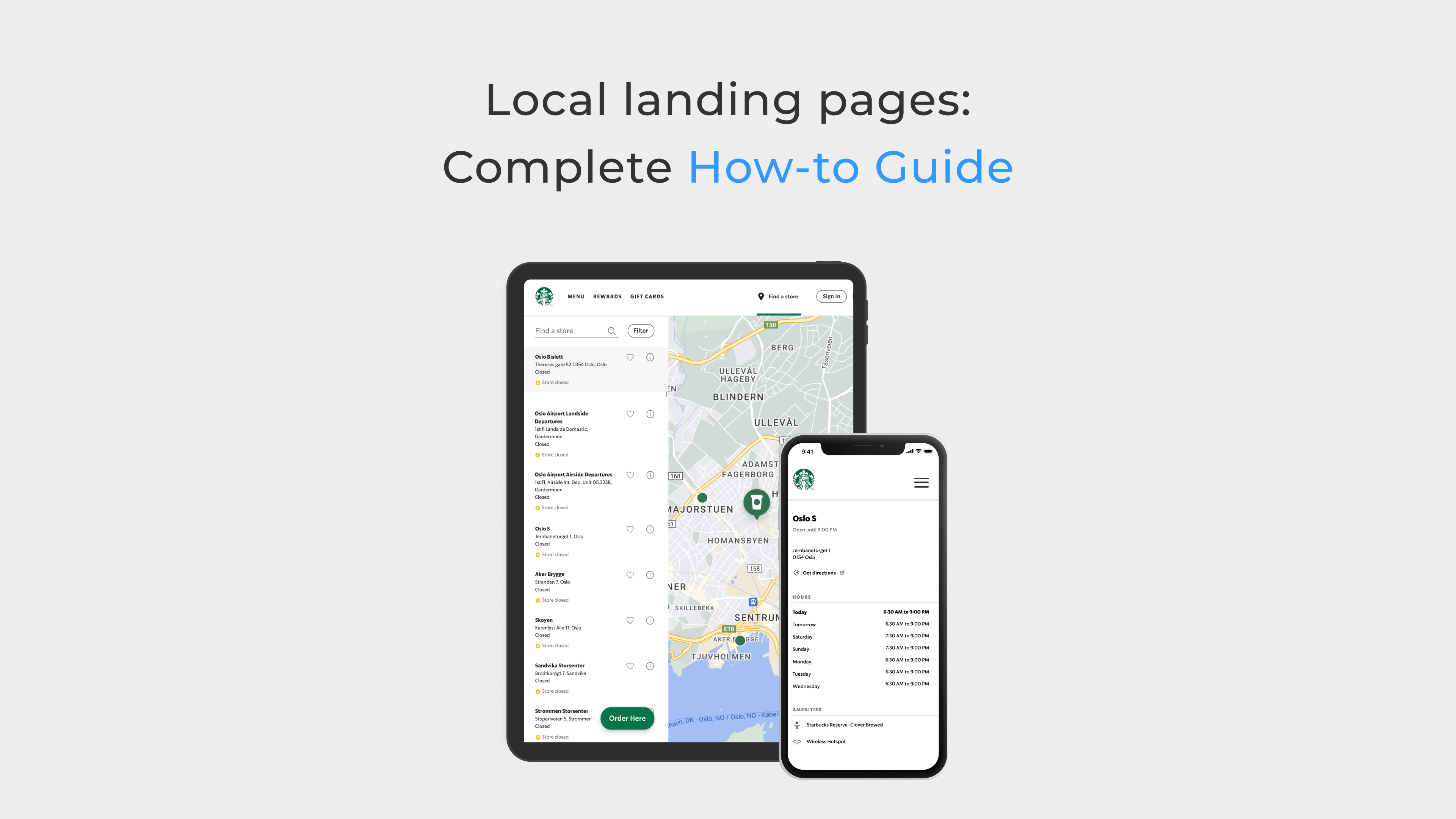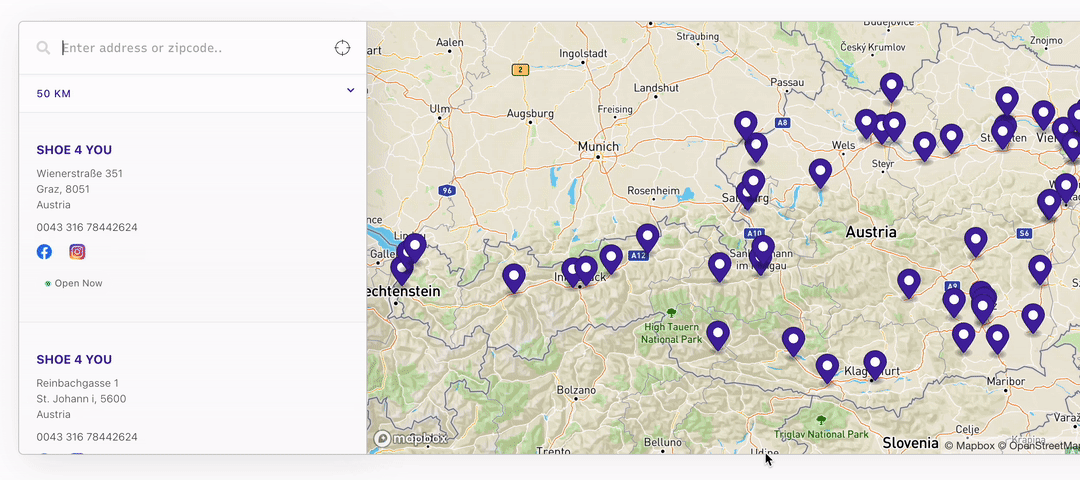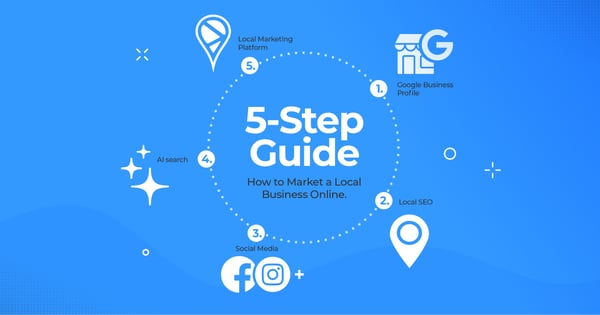Customers don’t just search for a brand. They search for the closest location, the opening hours right now, and whether this specific store meets their needs.
That’s why local landing pages have become a core pillar of modern local search. With the rise of AI-powered search results, their importance has grown even further. And the right local landing pages don’t just improve rankings, but help customers choose your business faster and convert more traffic into store visits.

What Exactly Are Local Landing Pages?
Local landing pages are web pages that are tailored to a specific geographic location or service area.
The ultimate goal of developing a local landing page is to rank higher on local search results while effectively showcasing your products or services to the local customer.
They provide information about a business's products or services that are specific to a particular location or region, and they may include details like the business's address, hours of operation, or local contact information.
Why Are Local Landing Pages Important?
In a nutshell, local landing pages give users the exact information they need at the moment they’re deciding where to go.
Search engines and AI systems reward this because their goal is to return results that are relevant, trustworthy, and locally specific.
Strong local landing pages help you:
• Rank higher for “near me” and geo-intent searches
• Appear more often in map results and AI summaries
• Convert visitors faster with Call / Book / Order / Directions / Message CTAs
• Build trust with location-specific reviews and photos
If you have multiple stores but only one general page, you’re forcing customers (and search engines) to guess — and that often means lost visibility and lost revenue.
How Are Local Landing Pages Different from Regular Landing Pages?
The answer is fairly simple: Regular landing pages are more generalized, while local landing pages are focused on a particular geographic area.
For instance, you could create a regular landing page that highlights the benefits of your service and encourages visitors to sign up for a free trial. This page would be aimed at a broad audience of potential customers.
However, if you also have offices in multiple cities, it is best to create a few local landing pages that provide more information about your service as well as specific location details. These local pages would be aimed specifically at people in that city who might want to pay you a visit in person.
How to Create a High-Ranking Local Landing Page in 6 Steps
1. Research your market and competition
To create a winning local landing page, you need to know your market and competition. Use tools like Google Analytics and Google Search Console to analyze the local search engine results pages (SERPs) and identify the top-ranking pages.
This data will give you insights into the local keywords that perform well, the content that resonates with the target audience, and the technical SEO elements that contribute to a high ranking. Use this information to see what content they provide, which local keywords they target, and how your landing page differs from theirs.
2. Define your goals and audience
Before you create a local landing page, you need to know what you want to achieve and who your target audience is. Use data from Google Analytics or customer surveys to determine the demographic and psychographic characteristics of your ideal customer.
Make sure you have data-driven answers to two key questions:
1. Where do you want your visitors to come from?
2. Where are most of your local visitors coming from right now?
Once you have a clear idea of both, delve deeper into the desired actions you want visitors to take, and how you can appeal to them on a personal level.
*Tip: Customer reviews are the bread and butter of your local SEO strategy, and they help potential customers trust and choose your business so include a bunch of them.
3. Choose the best location and keywords
For multi-location brands, choosing the right location for your landing page is essential. You need to pick the locations that have the most search volume and the highest potential for conversion. You can use tools like Google Keyword Planner, Semrush, or Ahrefs to identify the most popular search terms and locations for your industry.
When choosing keywords, it's important to strike a balance between specificity and relevance to the target audience's search intent. For example, if you're creating a local landing page for a restaurant in a popular tourist area you might want to focus on keywords that highlight the restaurant's location or its proximity to a popular attraction.
*Tip: Prioritise the transactional keywords over informational ones. Instead of keywords like "coffee beans" or "coffee brewing methods," try "best coffee in Oslo," "coffee near me in Oslo," or "local coffee shop in Oslo."
4. Design and structure your landing page
When creating your local landing page, use a clean and professional design that is consistent with your brand's look and feel. This means incorporating your brand's color scheme, typography, and other design elements into a visually appealing and cohesive page. A consistent design can help build trust with potential customers and reinforce your brand's identity.
When organising the content on your landing page, keep in mind that visitors should be able to quickly and easily find the information they're looking for. Use a logical and easy-to-read layout that makes it clear what your business offers and how it can benefit potential customers.
Also, Clear calls to action (CTAs) should be prominently displayed on the page, encouraging visitors to take the desired action. This includes strategically placing CTAs on the page and using language that communicates the benefit of taking the desired action.
*Tip: Including local keywords in the URL of your local landing page can help to reinforce its local focus.
5. Optimize for Local SEO (and AI search)
Local SEO isn’t just about keyword placement anymore — it’s about giving AI systems and search engines clear, structured, reliable local data they can trust.
Essentials of high-ranking, high-converting local landing pages:
✔ Local keywords in H1, metadata, and intro
✔ Consistent NAP + hours (including special holiday hours)
✔ LocalBusiness + FAQ structured schema
✔ Fast loading and mobile-first layout
✔ Unique photos with descriptive alt text
✔ Internal links to related services and nearby locations
Local Keywords
Use local keywords in the metadata (title tag, description, meta keywords) as well as the page title, headings, and content. This helps search engines understand the context of your landing page and its relevance to local search queries.
Also, don’t be afraid to pick low search volume or even 0 search volume keywords. While it might seem counterintuitive to target keywords that no one is searching for, the truth is that low-volume keywords can actually be highly targeted and offer less competition. By targeting these types of local keywords, you can potentially rank higher in search results and attract highly qualified traffic to your local landing page.
Consistent NAP
Ensure your NAP (name, address, phone number) is consistent and accurate across the entire website i.e. use the same NAP information on your local landing page, your website's footer, and any other directories where your business is mentioned. This consistency helps search engines understand that your business is a legitimate and trustworthy local entity.
Alt Text
Include relevant and location-specific keywords in the Alt text of your website's images so that the search engines can better understand the context of your content which will improve your chances of ranking higher in local search results. For example, if you’re a coffee shop in Oslo, including keywords like "Oslo coffee shop," "locally roasted coffee in Oslo," or "coffee near me Oslo" in your images’ Alt Text will boost your local SEO.
Schema Markup
Use schema markup on your local landing page to communicate the key details about your business like your NAP, hours of operation, reviews, etc. in a structured and standardized way that search engines can easily understand. This will also help your business appear in snippets - highly visible and eye-catching results that appear at the top of search results, showing your reviews, ratings, pricing, and other essential information.
*Tip: Embed a Google Map on your local landing page to help customers find your business easily. This will also signal search engines that your business is located in a specific area.
6. Test and refine your local landing page
Use A/B testing to compare different variations of the local landing page and see which performs best. Test elements such as the headline, call-to-action, form placement, and overall design to see what resonates most with your local target audience.
Use tools like Google Analytics to track the page's performance and gain insights into how visitors interact with it. Keep an eye on metrics like bounce rate, time on page, and conversion rate to identify areas that need improvement.
How PinMeTo Supports High-Performing Local Landing Pages
Local landing pages convert only when customers can rely on the information they find. That requires accuracy and consistency across every channel — including your own website.
• PinMeTo Listings centralizes business information such as opening hours, addresses, services, and contact details. When a location is updated in Listings, the change becomes available to the website immediately — avoiding outdated hours and mismatched addresses.
• Locator & Local Pages turns that verified data into a fast Store Locator and SEO-optimized landing pages for every branch. Because the pages are powered by the same source of truth, information stays current without manual edits for each location.
This helps brands avoid the most common reasons people abandon store pages: outdated hours, wrong addresses, and uncertainty about whether the location is open now.

What good vs. bad local landing pages look like
Bad pages:
✖ Same text and images on every location
✖ No opening hours or holiday hours
✖ No CTA above the fold
✖ Generic reviews or none at all
Great pages:
✔ Accurate NAP + hours synced everywhere
✔ Photos and reviews from this specific location
✔ Local content (parking, transport, access, nearby landmarks)
✔ Prominent CTAs (Call / Book / Order / Directions / Message)
✔ Connected to Store Locator + Google Business Profile
Customers take action faster, and Google/AI systems trust the page more, which drives more visibility, more clicks, and more store visits.
To Sum Up
Local landing pages help customers find the right location faster — and choose it with confidence. When each page is accurate, locally relevant, and easy to act on, you don’t just improve rankings; you remove friction and turn searches into real visits. The brands that win aren’t the ones with the most pages, but the ones with the most helpful pages.
FAQ: Local Landing Pages for Multi-Location Brands
What is a local landing page?
A local landing page is a webpage dedicated to a single store or branch, showing accurate location details, opening hours, services, and clear actions like Call, Directions, or Book.
Why are local landing pages important for local SEO?
They help businesses appear for geo-intent searches such as “near me,” “open now,” and “[service] + [city],” increasing both visibility and store visits.
What should every local landing page include in 2025?
Correct NAP (name, address, phone), opening hours, map, store-specific reviews, unique local content or photos, and conversion CTAs placed above the fold.
Do duplicate pages hurt performance?
Yes. Pages with nearly identical content across locations usually drop in rankings. Each location needs some unique and locally relevant information.
How can multi-location brands keep location pages updated automatically?
By managing location data in one source of truth (for example, PinMeTo Listings) so changes flow automatically to the website and PinMeTo Store Locator & Local Pages, preventing outdated hours or conflicting addresses.
Looking for ways to level up your local visibility?
Give us an overview of your business below and our experts will schedule a live demo with you.
Lily Adamyan, November 27



